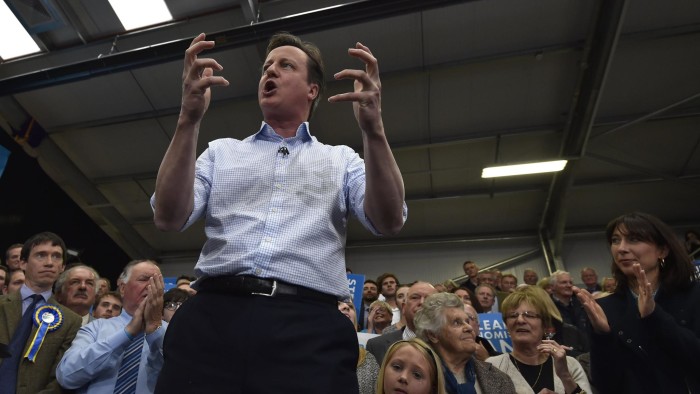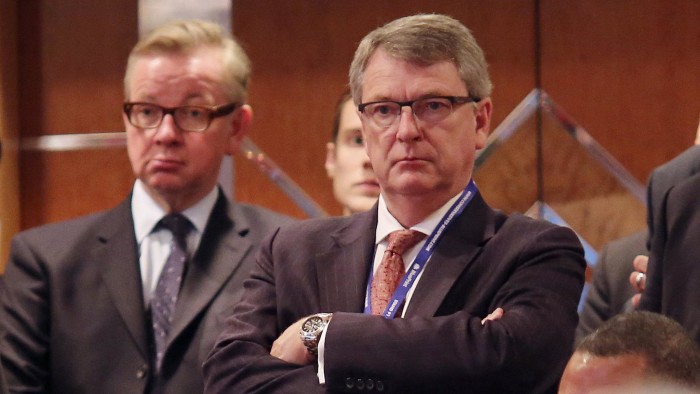UK election: How Cameron killed his coalition

Roula Khalaf, Editor of the FT, selects her favourite stories in this weekly newsletter.
On the eve of the longest election campaign in British history, Lynton Crosby, the Conservatives’ blunt strategist, gathered the party’s MPs in the Palace of Westminster and set out his game plan.
Despite polls showing the Tories in a dead heat with the opposition Labour party, Mr Crosby was in ebullient form. “He told us everything was in our favour,” says an MP who attended. “As long as we made the campaign about the economy and [Labour leader] Ed Miliband’s weakness.”
Mr Crosby, who cut his teeth in the world of macho Australian politics, had studied the data and knew victory was in the Conservatives’ grasp if they could just win over a few thousand voters in a few dozen marginal seats in England.
Confidence in the strategy waxed and waned in the tense six weeks that ensued — and the strategy itself sometimes wavered. But yesterday morning his approach was vindicated as the Conservatives confounded expectations by sweeping not just to victory but to a majority in parliament.
“The campaign managers were always confident that we could get there, but that confidence was not always shared at the top,” says a Conservative strategist. “Lynton was right all along.”
From the outset, David Cameron, prime minister, and George Osborne, chancellor and his closest political ally, were determined to learn from the mistakes of the 2010 election campaign. To the dismay of his backbenchers, Mr Cameron had failed to win a majority against an unpopular, long-serving Labour government led by Gordon Brown and was forced into coalition with the Liberal Democrats.
The 2010 Tory campaign suffered from a proliferation of armchair strategists. “This time, the campaign had to be much more disciplined,” says one Cabinet minister.
Mr Crosby had helped to steer John Howard to four successive election victories in his native Australia, and he had managed two victories in a row for Boris Johnson, the mayor of London. But some critics such as Lord Ashcroft, the Tory peer-turned-pollster, warned that Mr Crosby would run a repeat of Michael Howard’s futile 2005 campaign against Labour’s Tony Blair.

Mr Crosby’s plan this time was ruthlessly simple. First, undermine Mr Miliband as a credible alternative to Mr Cameron as prime minister. Second, turn on their coalition partners, bombarding traditional Lib Dem strongholds in the southwest of England with a hugely expensive targeted marketing campaign. Third, focus on the performance of the UK economy, where more than 2m jobs had been created, the budget deficit halved and income tax cut.
On paper, the first phase of the campaign appeared compelling. MPs and activists were enthused, but the message did not move the poll numbers — and it failed to take into account a new development in British politics.
Interactive

The Conservatives have secured a majority and the SNP have secured most seats in Scotland
The conditions of the 2010 Conservative-Lib Dem coalition included a fixed term, five-year parliament and therefore a campaign lasting six weeks, double the length of normal party hostilities. Within two weeks, Tories began to fret that no one was paying attention; worse, the rosy economic message did not seem to resonate beyond London.
“There was no feelgood factor,” recalls another Cabinet minister. “And every time we went to the north, we were asked on BBC radio to apologise for food banks.”
Mr Miliband was also outperforming expectations, admittedly from a low base. His promise to abolish tax breaks for “non-doms” (UK residents domiciled abroad for tax purposes) struck a chord, at least in the media. A highly personal attack on Mr Miliband by Michael Fallon, defence secretary, betrayed Tory jitters.
“The Fallon attack, [in which he accused Mr Miliband of planning to “stab Britain in the back”] was a sign that things definitely weren’t going our way,” says one minister. “The campaign was starting to get wobbly knees.”
At the launch of the party’s manifesto in mid-April, the Conservatives’ rhetoric shifted from Mr Osborne’s stern commitment to budget rigour to a sunny optimism sweetened by giveaways. He offered £8bn a year extra for the National Health Service by 2020, free childcare for working families and a controversial extension of the Right to Buy housing scheme — all without saying how they would be funded.
Strategists argue that this was the campaign’s “retail moment”. The Tories had “earned the right” to make such promises by proving their commitment to fiscal credibility in the previous five years. The evidence on the ground suggested they were right.
“Voters heard all this and they told us, ‘Don’t worry, we know you’re good for it’,” says one MP. Others were less sure about the abrupt U-turn. “The blizzard of announcements may have helped neutralise Labour, but it looked odd because the commitments were so enormous,” says another MP. Big business became unnerved too. The personal attacks on Mr Miliband were not working. The unfunded spending promises were jarring. And the performance of the UK economy — which was performing among the best in western Europe — had failed to translate in the polls. And Mr Cameron appeared lacklustre.
As an MP said at the time: “I don’t know if there is something wrong with him, whether he’s had some bad news. But whatever it is — he’s got to raise his game for the sake of the country.”
Charles Moore, the columnist for The Daily Telegraph, said the prime minister was overly confident, accusing him of being “too posh to push”.
Inside Tory headquarters in Matthew Parker Street near St James’s Park, London, the mood was more resilient. Mr Crosby was adamant that his plan was working but national polls were not picking up the crucial data on voting intentions in marginal constituencies.
Mr Crosby knew he had one final trump card to play: the risk of a future Labour government propped up by the Scottish National party.
The SNP’s surge in Scotland was turning into a tsunami, helped by Nicola Sturgeon, its articulate and tenacious leader, emerging as the star of the election. One poll by Ipsos Mori a week away from election day showed that the pro-independence party would win every single Scottish seat. (The SNP won 56 out of 59 seats).
These figures proved to be a catastrophe for Labour, which for decades had dominated Scottish politics. In previous campaigns, Labour could count on more than 40 seats to help them to the minimum 326 Westminister seats needed to command a majority in parliament.
“The polls weren’t lying,” says one Scottish Labour MP. “We were getting the same message on the doorstep.”
Labour’s slump in Scotland brought a halt to the momentum Mr Miliband appeared to be generating in England. It also undermined his party’s strategy of appealing to the core base necessary to scrape over the finishing line with around 35 per cent of the national vote.
What the pollsters and pundits were missing was the Tories’ relentless ground campaign focusing on marginal seats — particularly in the Midlands and southwest of England, where Liberal Democrats had been dug in for a generation or more. Mr Cameron, by now appearing energised, made regular visits to Devon and Cornwall in towns such as St Austell. They would go on to take 27 seats from the Lib Dems.
In the southeast, the Tories claimed their most sought-after scalp: Nigel Farage, the leader of the UK Independence party, whose blokeish charm at one point made him look like a sure winner in the Kent seat of South Thanet.
Tory high command was determined to see off Mr Farage and the threat of Ukip, which was siphoning off votes and eurosceptic MPs. “If you want to win the Vietnam war, you don’t just bomb the paddy fields, you kill Ho Chi Minh,” says a Tory strategist.
At the same time, the SNP tactic was proving lethal. “People saw Ed Miliband during the televised leaders’ debates. He was not as frightening as they may have thought,” says a Tory insider. “But English voters would tell us they were scared of Nicola Sturgeon: they thought she was going to storm south of the border and steal our money.”
Some worried about the long-term effect of playing the SNP card. Lord Forsyth and other Scottish Conservatives were alarmed by what they viewed as an appeal to English nationalism that could ultimately put the United Kingdom at risk. Mr Crosby and his fellow campaign strategists were unmoved. They piled money into a large-scale poster campaign depicting Mr Miliband in Ms Sturgeon’s pocket. “Don’t let the SNP hold Britain to ransom,” ran the tagline.
In the end, Mr Crosby ran a textbook US-style campaign, which dismantled his opponents and focused on battleground areas. As a student of American politics, Mr Miliband might come to appreciate the lesson. As for Mr Crosby, he is ready to go back to his old job as a political consultant, having delivered a victory that most of his Tory clients thought was impossible to deliver.
. . .
Letter in response to this article:
Opportunity for a British alliance on German model / From Michael Williams
Comments